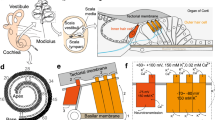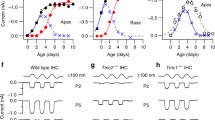Abstract
In this chapter, we will introduce the cellular structure that is responsible for hair-cell mechanotransduction (MET). Auditory hair cells reside in the inner ear, where they are interlaced in a precise pattern with various supporting cells. Hair cells got their name because each one has hundreds of hairy-looking membrane protrusions, namely, stereocilia, extending from its apical surface. Within each hair cell, various types of extracellular links couple different stereocilia with one another. Tip links connect the tips of shorter stereocilia to the lateral shaft of its taller neighbouring stereocilia, and the yet-unidentified MET channels localize at the tips of shorter stereocilia, near the lower end of tip links. When the stereocilia are deflected positively, tension of tip links increases, which changes the conformation of MET channels and increases their open probability. Driven by the potential difference and ion concentration difference, cations flux into hair cells through the MET channels and cause membrane depolarization.
Access this chapter
Tax calculation will be finalised at checkout
Purchases are for personal use only
Similar content being viewed by others
References
Liberman, M.C. 1982. The cochlear frequency map for the cat: labeling auditory-nerve fibers of known characteristic frequency. The Journal of the Acoustical Society of America 72 (5): 1441–1449.
Muller, M. 1991. Frequency representation in the rat cochlea. Hearing Research 51 (2): 247–254.
Kiang, N.Y., et al. 1986. Single unit clues to cochlear mechanisms. Hearing Research 22: 171–182.
Dallos, P. 1992. The active cochlea. The Journal of Neuroscience 12 (12): 4575–4585.
Tilney, L.G., M.S. Tilney, and D.J. DeRosier. 1992. Actin filaments, stereocilia, and hair cells: how cells count and measure. Annual Review of Cell Biology 8: 257–274.
Zhang, D.S., et al. 2012. Multi-isotope imaging mass spectrometry reveals slow protein turnover in hair-cell stereocilia. Nature 481 (7382): 520–524.
Drummond, M.C., et al. 2015. Live-cell imaging of actin dynamics reveals mechanisms of stereocilia length regulation in the inner ear. Nature Communications 6: 6873.
Lindeman, H.H., et al. 1971. The sensory hairs and the tectorial membrane in the development of the cat s organ of Corti. A scanning electron microscopic study. Acta Oto-Laryngologica 72 (4): 229–242.
Tanaka, K., and C.A. Smith. 1978. Structure of the chicken’s inner ear: SEM and TEM study. The American Journal of Anatomy 153 (2): 251–271.
Denman-Johnson, K., and A. Forge. 1999. Establishment of hair bundle polarity and orientation in the develo** vestibular system of the mouse. Journal of Neurocytology 28 (10–11): 821–835.
Goodyear, R., and G. Richardson. 1992. Distribution of the 275 kD hair cell antigen and cell surface specialisations on auditory and vestibular hair bundles in the chicken inner ear. The Journal of Comparative Neurology 325 (2): 243–256.
Goodyear, R.J., et al. 2005. Development and properties of stereociliary link types in hair cells of the mouse cochlea. The Journal of Comparative Neurology 485 (1): 75–85.
Tilney, L.G., and M.S. Tilney. 1986. Functional organization of the cytoskeleton. Hearing Research 22: 55–77.
Kaltenbach, J.A., P.R. Falzarano, and T.H. Simpson. 1994. Postnatal development of the hamster cochlea. II. Growth and differentiation of stereocilia bundles. the Journal of Comparative Neurology 350 (2): 187–198.
Zine, A., and R. Romand. 1996. Development of the auditory receptors of the rat: a SEM study. Brain Research 721 (1–2): 49–58.
Flock, A. 1964. Electron microscopic and electrophysiological studies on the lateral line canal organ. Acta Oto-Laryngologica. Supplementum SUPPL 199: 1–90.
Shotwell, S.L., R. Jacobs, and A.J. Hudspeth. 1981. Directional sensitivity of individual vertebrate hair cells to controlled deflection of their hair bundles. Annals of the New York Academy of Sciences 374: 1–10.
Pickles, J.O., S.D. Comis, and M.P. Osborne. 1984. Cross-links between stereocilia in the guinea pig organ of Corti, and their possible relation to sensory transduction. Hearing Research 15 (2): 103–112.
Kachar, B., et al. 2000. High-resolution structure of hair-cell tip links. Proceedings of the National Academy of Sciences of the United States of America 97 (24): 13336–13341.
Tsuprun, V., R.J. Goodyear, and G.P. Richardson. 2004. The structure of tip links and kinocilial links in avian sensory hair bundles. Biophysical Journal 87 (6): 4106–4112.
Furness, D.N., and C.M. Hackney. 1985. Cross-links between stereocilia in the guinea pig cochlea. Hearing Research 18 (2): 177–188.
Assad, J.A., G.M. Shepherd, and D.P. Corey. 1991. Tip-link integrity and mechanical transduction in vertebrate hair cells. Neuron 7 (6): 985–994.
Kazmierczak, P., et al. 2007. Cadherin 23 and protocadherin 15 interact to form tip-link filaments in sensory hair cells. Nature 449 (7158): 87–91.
Beurg, M., et al. 2009. Localization of inner hair cell mechanotransducer channels using high-speed calcium imaging. Nature Neuroscience 12 (5): 553–558.
Schwander, M., et al. 2009. A mouse model for nonsyndromic deafness (DFNB12) links hearing loss to defects in tip links of mechanosensory hair cells. Proceedings of the National Academy of Sciences of the United States of America 106 (13): 5252–5257.
Alagramam, K.N., et al. 2011. Mutations in protocadherin 15 and cadherin 23 affect tip links and mechanotransduction in mammalian sensory hair cells. PLoS One 6 (4): e19183.
Geng, R., et al. 2013. Noddy, a mouse harboring a missense mutation in protocadherin-15, reveals the impact of disrupting a critical interaction site between tip-link cadherins in inner ear hair cells. The Journal of Neuroscience 33 (10): 4395–4404.
Barr-Gillespie, P.G. 2015. Assembly of hair bundles, an amazing problem for cell biology. Molecular Biology of the Cell 26 (15): 2727–2732.
Ross, A.J., et al. 2005. Disruption of Bardet-Biedl syndrome ciliary proteins perturbs planar cell polarity in vertebrates. Nature Genetics 37 (10): 1135–1140.
Jones, C., et al. 2008. Ciliary proteins link basal body polarization to planar cell polarity regulation. Nature Genetics 40 (1): 69–77.
Author information
Authors and Affiliations
Corresponding author
Rights and permissions
Copyright information
© 2018 The Author(s)
About this chapter
Cite this chapter
Xu, Z. (2018). Cellular Structure for Hair-Cell Mechanotransduction. In: Mechanotransduction of the Hair Cell. SpringerBriefs in Biochemistry and Molecular Biology. Springer, Singapore. https://doi.org/10.1007/978-981-10-8557-4_2
Download citation
DOI: https://doi.org/10.1007/978-981-10-8557-4_2
Published:
Publisher Name: Springer, Singapore
Print ISBN: 978-981-10-8556-7
Online ISBN: 978-981-10-8557-4
eBook Packages: Biomedical and Life SciencesBiomedical and Life Sciences (R0)




